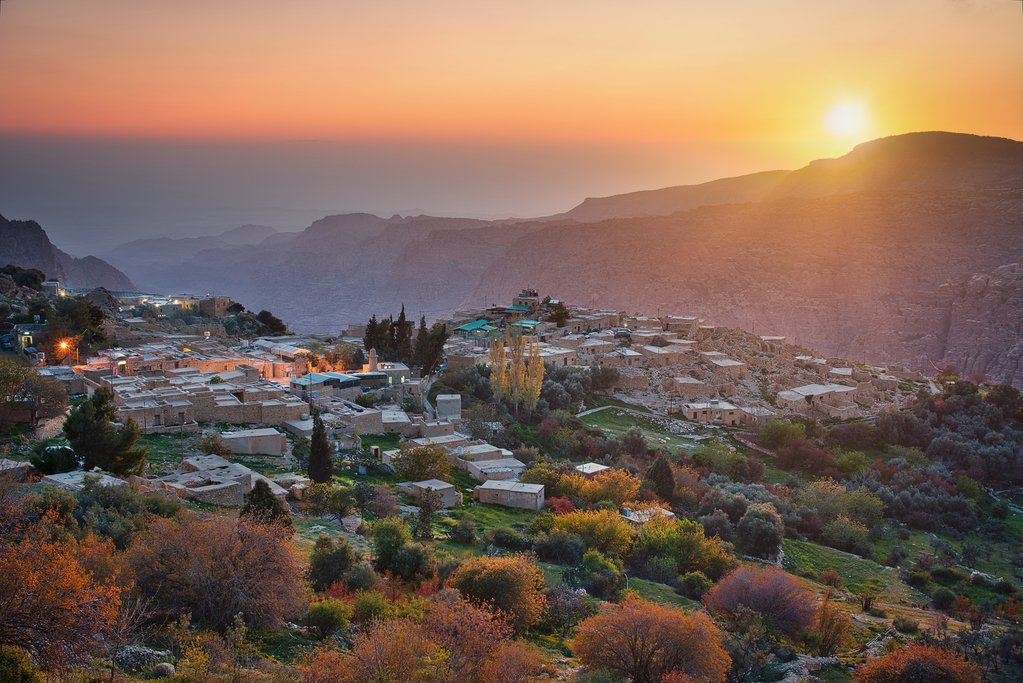Weather
Things get still-comfortably toasty throughout Jordan in May. Always one of the cooler spots, Amman averages 72°F (22°C), with a daily range between 64-82°F (18-28°C). Petra is quite a bit warmer, averaging 80°F (25°C) for the month. The desert region and Gulf of Aqaba shore will be quite hot by mid-May (Aqaba averages 91°F/33°C for the month). However, even temperatures that high are usually comfortable, thanks to the low humidity. The Gulf of Aqaba water temperature is also warm (averaging around 75°F/24°C in May).
Bring plenty of sunscreen, plus a shade hat, sunglasses, and comfortable yet sturdy walking shoes.
The chance of rain drops substantially as the month progresses, although the landscapes (even the desert) are still brightened by the final weeks of the spring wildflower bloom. Beginning in May, however, Jordan is prone to the khamseen, a dry and sometimes gale force desert wind that can whirl in from the Arabian Peninsula, drawn by low pressure. Laden with sand and dust, it can last for weeks, but more typically it dies down after a few days. Although it darkens the skies, the hot wind raises the temperature by as much as 50°F (10°C), and rapidly.
Crowds & Costs
May is one of the two most popular months to visit Jordan (October is the other). Hence, flights and lodging are at their most expensive, with relatively few bargains. It’s wise to book flights and reserve accommodations well in advance, especially in the main tourist areas.
Where to Go
While visiting Petra is always an incredible experience, it can be extremely hot by late May. Visit by night, when it’s cool, to experience a magical new dimension. Candles will light your way through the Siq, guiding you to the Treasury to witness a traditional Bedouin performance in a breathtaking setting lit by more than 1,500 candles.
Head to Dana Biosphere Preserve before the wildflower bloom fades. Feynan Ecolodge is a great base for exploring Jordan’s largest nature reserve and the only one that encompasses all four of the country’s bio-geographical zones. This is a great place to hike, with fingers crossed for sightings of such endangered mammal species as the Syrian wolf and Sand cat. Terrain spans elevations from 80 feet (50 m) below sea level to 5,577 feet (1,700 m), providing sufficient variety to fill several days.
Travelers with a bent for archaeology will want to visit the ancient dolmens of Wadi Jadid, some 6 miles (10 km) southwest of Madaba. The rugged hills around Madaba are studded with early Bronze age burial chambers made of great stone columns capped by equally massive stone slabs (“dolmen” means stone table). Wadi Jadid has the largest collection, with some 40 prehistoric dolmens and menhirs (freestanding stones), but there are scores of others scattered around. You’ll need to hike to reach them from the highway; wear sturdy footwear for the rocky terrain.
Chat with a local specialist who can help organize your trip.
What to Do
Fascinated by archaeology? Then take a busman’s holiday to admire Jordan’s outstanding Roman ruins. Tiny it may be, but the country boasts many world-class sites strewn across the country. Start with Amman’s Citadel, perched above the modern city and boasting a well-preserved amphitheater. Next, head north to Umm Qais, with its own amphitheater and splendid colonnades that speak to the former wealth of the ancient Decapolis city of Gadara. At Petra, stroll the great “Colonnaded Street” that once served as a commercial thoroughfare. And, most impressive of all, end with Jerash, where the wealth of remains include a well-preserved hippodrome still used for displays of gladiator duels and chariot races.
Or, retrace Crusader history by visiting Jordan’s six castles (bring a flashlight to explore unlit tunnels). Begin with the biggest and most important: Karak. One of the largest Crusader castles in the Levant, this sprawling, ruinous 12th-century hilltop stronghold had a commanding strategic location and was a target of many sieges, and fell under the control of the legendary Saladin. Then head south to Shobak Castle, another now-crumbling Crusader masterpiece. In the eastern desert is Qasr Al Azraq, a 13th-century castle that in 1917-18 was the base for TE Lawrence (“Lawrence of Arabia”) during the Arab Revolt.
Make a soak at the Ma’in Hot Springs your soothing reward after hiking in the Mujib Biosphere Reserve, of which it’s a part. Enshrining 82 sq ml (212 sq km) of rugged desert terrain between the King’s Highway and the Dead Sea, it protects seven wadis and the wildlife their precious waters sustain. Keep your eyes underfoot for the desert cobra, and your fingers crossed for a very rare sighting of the Syrian wolf or striped hyena. Among the most popular of the reserve’s many trails is the challenging 9 mile (15 km) Mujib Trail.
May Events
Jordan International Rally. This important off-road car race and challenge draws thousands of visitors to witness several drama-filled stages, plus a festival.
Traveling to Jordan in May? Check out these great itineraries
Experience Jordan Tour - 8 Days. This itinerary visits iconic sites, such as Jerash and Petra, and offers a medley of exciting experiences, from a camel ride to floating in the Dead Sea.
Desert Yoga Escape in Jordan: Wadi Rum & Little Petra - 9 Days. A camel ride in Wadi Rum, a therapeutic float in the Dead Sea, outdoor yoga at Little Petra, and sleeping under the stars are all part of this enlightening trip.
More Helpful Information
Jordan in April
Jordan in June
Best Time to Visit Jordan
How Many Days Should You Spend in Jordan?
